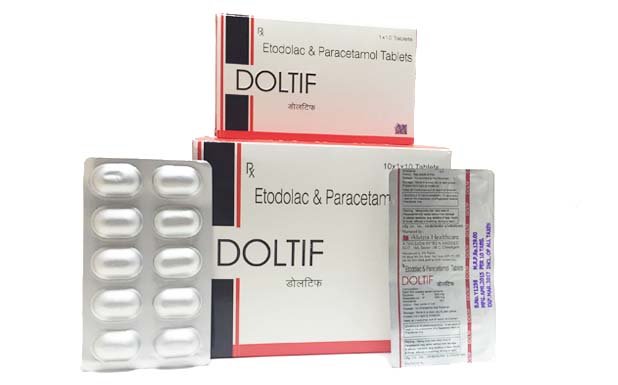
Composition
- Each Film Coated Tablet Contains:
- Etodolac IP
300 mg
- Paracetamol IP
325 mg
Packing
- 10x1x10
Alu-Alu
MRP
- 129
Overview
Etodolac is a nonsteroidal anti-inflammatory drug (NSAID). It works by reducing hormones that cause inflammation and pain in the body. Etodolac works by blocking the effect of natural substances in your body, called cyclo-oxygenase (COX) enzymes. These enzymes help to make other chemicals in your body, called prostaglandins. Paracetamol is a fast acting and safe analgesic with antipyretic property. The presence of Etodolac increases the effectiveness of Paracetamol.
INDICATIONS
It is indicated for acute or long-term use in rheumatoid arthritis and osteoarthritis.
Pharmacology
Pharmacodynamics Properties of Etodolac:
Etodolac is an anti-inflammatory agent with analgesic and antipyretic properties. It is used to treat osteoarthritis, rheumatoid arthritis and control acute pain. The therapeutic effects of etodolac are achieved via inhibition of the synthesis of prostaglandins involved in fever, pain, swelling and inflammation.
Mechanism of Action:
Similar to other NSAIDs, the anti-inflammatory effects of etodolac result from inhibition of the enzyme cycooxygenase (COX). This decreases the synthesis of peripheral prostaglandins involved in mediating inflammation. Etodolac binds to the upper portion of the COX enzyme active site and prevents its substrate, arachidonic acid, from entering the active site. Etodolac was previously thought to be a non-selective COX inhibitor, but it is now known to be 5 – 50 times more selective for COX-2 than COX-1.
Pharmacokinetics Properties of Etodolac:
ABSORPTION: The systemic bioavailability of etodolac from tablet is at least 80%PROTEIN BINDING: > 99% bound, primarily to albumin
METABOLISM: Etodolac is extensively metabolized in the liver.
EXCRETION: Etodolac is excreted unchanged in the urine.
Pharmacodynamics Properties of Paracetamol:
There presents a weak inhibition of COX-1 and COX-2 which is translated into a low anti-inflammatory activity. Therefore, in high inflammatory conditions, such as rheumatoid arthritis, these agents show limited in vivo suppression of inflammation and platelet activity. The formation of N-arachidonoylphenolamine, donates paracetamol with analgesic and antipyretic properties.
Pharmacokinetics Properties of Paracetamol:
ABSORPTION: Paracetamol is readily absorbed from the gastrointestinal tract.DISTRIBUTION:Peak plasma concentrations occur about 10 to 60 minutes after oral doses. Paracetamol is distributed into most body tissues. It crosses the placenta and is present in breast milk. Plasma-protein binding is negligible at usual therapeutic concentrations but increases with increasing concentrations.
METABOLISM: Peak plasma concentrations occur about 10 to 60 minutes after oral doses. Paracetamol is distributed into most body tissues. It crosses the placenta and is present in breast milk. Plasma-protein binding is negligible at usual therapeutic concentrations but increases with increasing concentrations.
ELIMINATION: It is excreted in the urine, mainly as the glucuronide and sulfate conjugates. The elimination half-life varies from about 1 to 4 hours.
CONTRAINDICATIONS
Contraindicated in known hypersensitivity to paracetamol, in hepatic and renal failure
SIDE EFFECTS
The common side effects are:
- Constipation
- Diarrhea
- Vomiting
- Dizziness
- Runny nose
- Sore throat